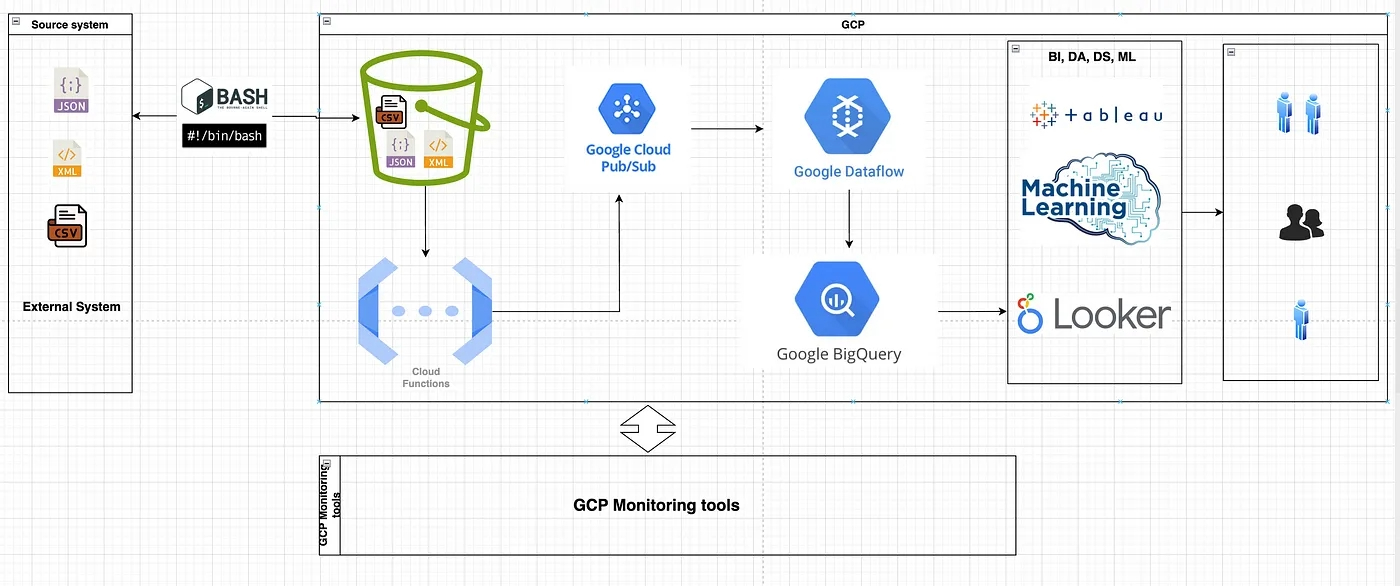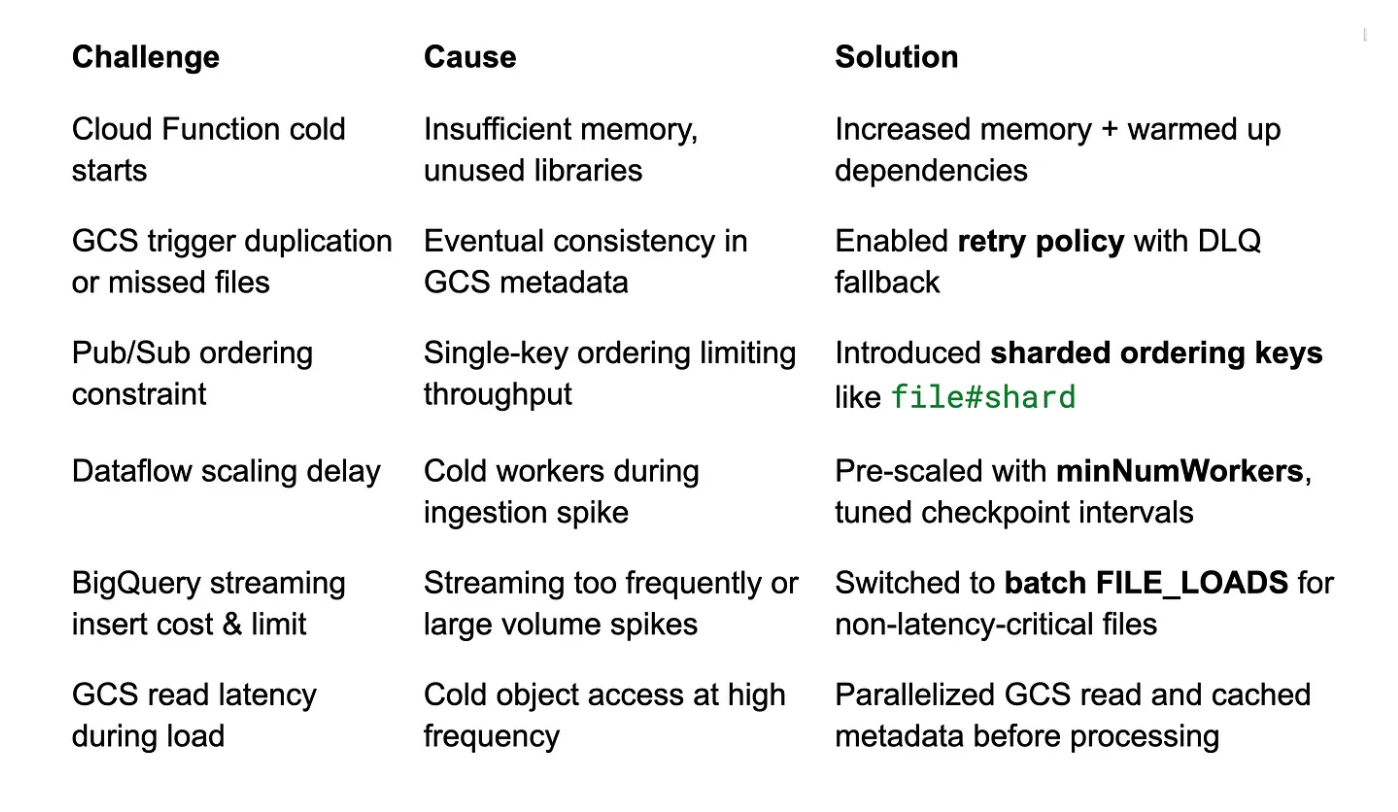Ingest 10TB of data per day
Maintain sub-second end-to-end latency
Remain fully serverless, reliable, and production-grade
This post details our architecture, the challenges we encountered, and how we optimized the system to meet both performance and cost-efficiency goals.
Objectives
Ingestion volume: 10TB/day (~115MB/sec sustained)
Latency target: < 1 second from data upload to visibility in BigQuery
Design constraints: Serverless, autoscaling, minimal ops
Core services: Cloud Functions, Pub/Sub, Dataflow (Apache Beam), BigQuery
Architecture Design & Overview
[Data Producers → GCS Upload]
↓
(Object Finalization Event) [Cloud Function Triggered by GCS]
↓
[Pub/Sub Topic (Buffer)]
↓
[Dataflow Streaming Job]
↓
[BigQuery (Analytics Layer)]
Cloud Function Triggered by GCS Upload
Our ingestion pipeline begins when files are uploaded to Google Cloud Storage. A Cloud Function is automatically triggered by GCS “object finalized” events.
This function:
Parses GCS metadata (bucket, filename, timestamp, source)
Adds custom tags or schema versioning info
Publishes a message to a Pub/Sub topic with metadata
Optimizations
Allocated enough memory (~512MB) to reduce cold starts
Reused network clients to avoid socket overhead
Enabled 1000 concurrent executions with no retry deadlocks
Pub/Sub: Decoupling & Buffering
Pub/Sub acted as our message buffer, enabling:
Horizontal scaling of downstream consumers
Replay capabilities in case of downstream failure
Backpressure protection via flow control
Each message carried metadata needed by Dataflow to load, transform, and route the data.
Dataflow: Stream Processing Engine
We used Dataflow (Apache Beam, Java SDK) in streaming mode to:
Fetch and parse raw file content from GCS
Apply schema-aware transformations
Handle deduplication using windowing and watermarking
Write enriched data to BigQuery with sub-second delay
Dataflow Optimizations
Enabled Streaming Engine + Runner v2
Used dynamic work rebalancing and auto-scaling (5–200 workers)
Split large files into smaller chunks (ParDo + batching)
BigQuery: Real-Time Analytics Layer
Data was streamed into a landing table in BigQuery via streaming insert. A separate scheduled transformation job partitioned and clustered data into curated tables.
BigQuery Optimizations
Partitioned by ingestion date
Clustered by source_id, event_type
Compacted daily files using scheduled queries
Used streaming buffer metrics to detect lag spikes
Bottlenecks & Challenges
Recovery and Observability
Retries: Cloud Functions and Pub/Sub retries + backoff
Dead-letter queues: For malformed events or schema mismatches
Logging: Centralized with Cloud Logging and custom labels
Metrics: Data freshness, latency, throughput, and error counts
Reprocessing: Manual or scheduled Dataflow replay from GCS + Pub/Sub
Monitoring, Cost Optimization & Failure Recovery
Building a highly performant ETL pipeline isn’t enough; you also need observability and resilience. Here’s how we ensured visibility, cost control, and robust error handling in our 10TB/day GCP ETL pipeline.
Monitoring the Pipeline
We leveraged Cloud Monitoring and Logging to track every component in real time:
Cloud Function:
Monitored invocation count, execution duration, and error rates using Cloud Monitoring dashboards.
Configured alerts for failed executions or abnormal spikes in duration.
Pub/Sub:
Tracked message backlog and throughput via Pub/Sub metrics.
Alerts were set to detect message backlog growth, indicating slow or failing subscribers.
Dataflow:
Monitored autoscaling behavior, CPU utilization, memory usage, and system lag.
Configured custom lag alerts to catch delays in processing (e.g., high watermarks lagging behind ingestion).
Used Dataflow job logs to debug transformation errors, memory issues, or skewed partitions.
BigQuery:
Monitored streaming insert errors and throughput using the BigQuery audit logs.
Tracked query cost, slot usage, and latency to optimize performance and budget.
Tooling: Cloud monitoring dashboards were customized for our pipeline, with charts for:
Throughput (files/min, records/sec)
Latency (end-to-end from GCS to BQ)
Job failure alerts
Cost metrics per service (BQ storage/query, Dataflow VMs, etc.)
Results
Scaled to 10TB/day sustained load
Achieved end-to-end latency of ~600ms on average
Fully serverless and autoscaling with minimal ops overhead
Real-time querying and downstream analytics are available within seconds
Lessons Learned
Cloud-native doesn’t mean that compromise sub-second latency is achievable with the right patterns.
File-based triggers from GCS are reliable if you design for retries and idempotency.
The key to performance is pre-scaling, batch tuning, and decoupling stages.
Conclusion
GCP provides a robust foundation for building high-throughput, low-latency ETL pipelines. By combining event-driven triggers, Pub/Sub decoupling, and streaming dataflows, we were able to handle terabytes of data per day with real-time SLAs.
Whether you’re modernizing a batch system or building greenfield streaming architecture, this design can act as a blueprint. Contact us to learn more or check out our career page to find out how you can be a part of the Improving team.







